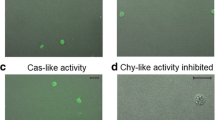Summary
The formation of porphyrins from porphobilinogen by a duck blood hemolysate was examined. The system was found to form mainly protoporphyrin IX and hemin, and accumulated lesser amounts of uroporphyrins, heptacarboxylic porphyrin, and coproporphyrins. By storage at −20° the accumulation of uroporphyrins and heptacarboxylic porphyrin was increased. Both porphyrins were mainly the type III isomers. By addition of dithiothreitol the porphyrin pattern reversed to the original one formed by the fresh hemolysate. Addition of a number of amines also inhibited the decarboxylating system without affecting the original isomer distribution among the porphyrins. Addition of Fe2+ (3mm) did not affect the porphyrin pattern or the isomer distribution. Addition of Pb2+ (2.5mm) partially inhibited the decarboxylating system, whereas at higher concentrations (4mm) it increased the decarboxylation rate of the heptacarboxylic porphyrin. The obtained results are discussed in relation to porphyrin accumulation in porphyria cutanea tarda and in acquired hepatic porphyrias.
Similar content being viewed by others
References
Shemin, D., 1955.The Harvey Lectures, 50, 258.
Romeo, G., and Levin, E. Y., 1971.Biochim. Biophys. Acta, 230, 330.
Lascelles, J., 1964. Tetrapyrrole Biosynthesis and its Regulation, Benjamin, New York.
Jackson, A. H., Sancovich, H. A., Ferramola, A. M., Evans, N., Games, D. E., and Martin, S. A., 1976.Phil. Trans. R. Soc. Lond. B, 273, 191.
Goldstein, J. A., Hickman, P., Bergman, H., and Vos, J. G., 1973.Res. Comm. in Chem. Pathology and Pharmacology, 6, 919.
Kushner, J. P., and Barbuto, A. J., 1974.Clin. Res., XXII, 178A.
Watson, C. J., Cardinal, R. A., Bossenmaier, I., and Petryka, Z. J., 1976.Proc. Nat. Acad. Sci. U.S.A., 73, 1323.
Schermuly, E., and Doss, M., 1976.Annals of Clin. Res., 8,Suppl. 17, 92.
Kushner, J. P., Lee, G. R., and Nacht, S., 1972.J. Clin. Invest., 51, 3044.
Blekkenharst, G. H., Pimstone, N. R., Webber, B. L., and Eales, L., 1976.Annals of Clin. Res. 8,Suppl. 17, 108.
Frydman, R. B., and Feinstein, G., 1974.Biochim. Biophys. Acat, 293, 506.
Frydman, R. B., and Frydman, B., 1970.Arch. Biochem. Biophys., 136, 193.
Doss, M., 1967.J. Chromatogr., 30, 265.
Bogorad, L., 1963.Ann. N.Y. Acad. Sci., 104, 676.
Author information
Authors and Affiliations
Additional information
Dedicated to professorLuis F. Leloir on the occasion of his 70th birthday.
Rights and permissions
About this article
Cite this article
Frydman, R.B., Frydman, B. & Feinstein, G. Porphyrin biosynthesis from porphobilinogen by duck blood hemolysate. Mol Cell Biochem 16, 187–192 (1977). https://doi.org/10.1007/BF01732060
Issue Date:
DOI: https://doi.org/10.1007/BF01732060




